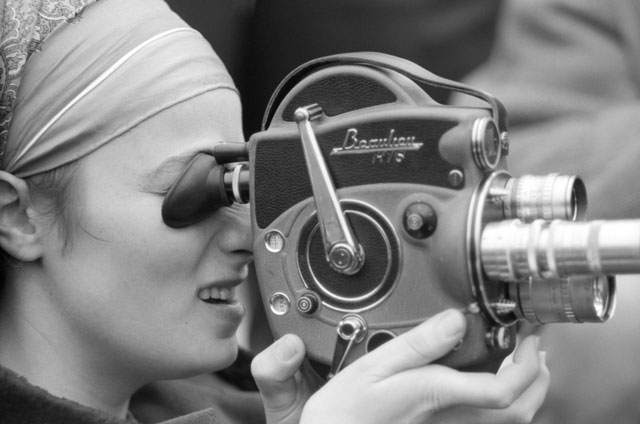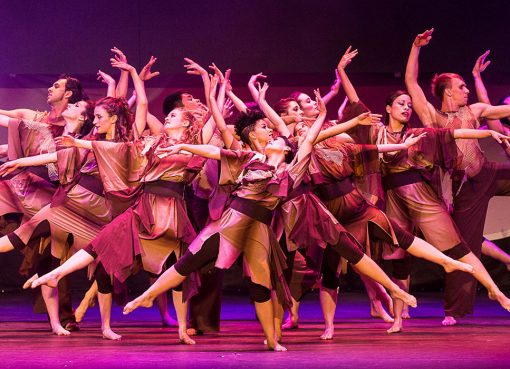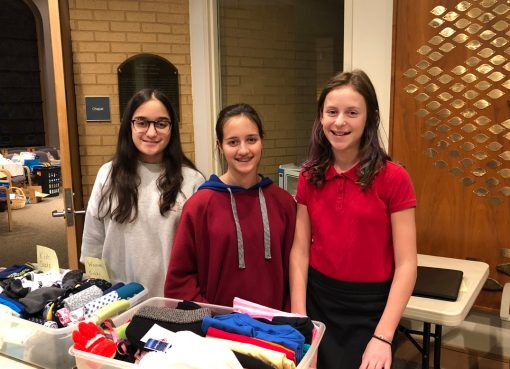Add These 10 Jewish Films from 2018 to Your Queue
For movie lovers across the country, the first few weeks in February are traditionally marked by a binge-watch of all the Oscar-nominated films in preparation for the big night—this year, on February 24th. As you plan your weekend viewing, here are some movies to consider adding to your queue. Read on for an article that was recently featured in Tablet magazine about Jewish films to watch from the last year.
The Esthers: Top 10 Jewish Films of 2018
World War II, the Cold War, American racism, Polish introspection, and Jerry Lewis
By J. Hoberman, film columnist for Tablet magazine and author, co-author or editor of 12 books, including Bridge of Light: Yiddish Film Between Two Worlds and, with Jeffrey Shandler, Entertaining America: Jews, Movies and Broadcasting.
Why struggle to reframe a suitably Talmudic answer to the eternal question—what makes a Jewish film Jewish? Here is the simplest, most arbitrary formulation. A Jewish movie is a movie that strikes me as being of at least potential interest to the Tablet readership. Here is a top 10 of such films seen over the past year in not quite arbitrary order:
1. Les Quatre Sœurs Claude Lanzmann’s last film, which opened in France the day before his death, age 93, and has been released in the United States as Shoah: Four Sisters, presents lengthy, hitherto unseen interviews with four Holocaust survivors, all of them women. Drawn from Shoah’s “outtakes,” the movie is less rigorous than Lanzmann’s masterpiece—it occasionally uses period photographs and the filmmaker is often present on camera, a gruff, chain-smoking interlocutor—but, once the women start talking, it similarly plays out in the mind’s eye.
Intentionally or not, Lanzmann’s subjects, who are all amazingly resilient and fully conscious of the part that blind chance played in their individual survival, explicate specifically female roles: mother, daughter and wife. Les Quatre Sœurs opens with its most horrific story, subtitled “The Hippocratic Oath,” that of Ruth Elias, a woman who—the unwilling subject of a Mengele experiment—gave birth in the shadow of the crematoria at Auschwitz. (I would have listed this movie first for her interview alone.)
Also indelible: Ada Lichtman’s account of her work at the death camp Sobibor, which she was one of the very, very few to survive. Her job, demonstrated while talking to Lanzmann, was dressing the dolls confiscated from doomed Jewish children that were refurbished as gifts to be sent to Germany—anecdote raised to mythic stature.
2. The Ancient Law (1923) Made in 1923 and set in the 1860s, the German director E.A. Dupont’s restored and painstakingly reconstructed silent feature is a classic retelling of the Jewish show biz assimilation saga—an analogue to Sholem Aleichem’s novel The Nightingale, Mark Arnsteyn’s play Der Vilner Balabesl, and, of course, all iterations of The Jazz Singer.
The respect and attention to detail with which Dupont tells the tale of a rabbi’s stage-struck son who leaves his Galician shtetl (apparently filmed on location in Poland) for success as a star player in Vienna’s Burgtheater, reflects on his grandparents’ migration from the periphery of the Habsburg Empire to its capital. The movie’s hero, Baruch Meyer, is played by a Jewish actor, Ernst Deutsch, who spent WWII in Hollywood playing second-string Nazis; his father Rabbi Meyer is played by another, Avrom Morevsky, a founding member of the Vilna Troupe who recreated his role as the tsadik in the 1937 Polish-Yiddish version of The Dybbuk (see below).
Unfortunately, Dupont, whose oeuvre includes such notable silents as Variety (1925) and Piccadilly (1929), did not enjoy Baruch Meyer’s success when forced to leave Germany for the U.S. in 1933. The Ancient Law has been playing Jewish film festivals and is also available on disc from Flicker Alley.
3. Les rendez-vous d’Anna (1978) Out of a more recent past, Chantal Akerman’s follow-up to her epochal Jeanne Dielman (1975) has been digitally restored on the occasion of its 40th anniversary. The movie is transparently autobiographical—an account of a young filmmaker, like Akerman herself, traveling to various cities, here Essen, West Germany, and showing her never-seen or described film. The subject is Akerman’s sense of herself as a woman, an artist and a Jew. Indeed, I don’t think I realized how profoundly Jewish Les Rendez-vous is until I saw the restoration that played at Brooklyn’s BAM this fall. If I read them correctly, the main characters are all Jews or Germans and the protagonist’s sense of homelessness, as the child of Holocaust survivors, mirrors Akerman’s own existential displacement in a deceptively bland landscape after battle.

4. Barbara Rubin and the Exploding NY Underground An astonishing embodiment of the 1960s, Barbara Rubin was an outer-borough red diaper baby intoxicated by the so-called New American Cinema. Appointing herself a sort of assistant to filmmaker-critic-organizer Jonas Mekas, she made the underground’s most sexually explicit movie, provocatively titled (after Rimbaud) Christmas on Earth before she was out of her teens, going on to organize pioneering light shows and mixed media events both in New York and London.
Rubin was not only a zealot but the underground’s prime networker—an aesthetic shadkhn who introduced Allen Ginsberg to Bob Dylan and turned Andy Warhol onto the Velvet Underground. Then, in her mid-20s, she gave up movies as Rimbaud gave up poetry. Rather than run guns to Africa, Rubin dropped out of the counterculture and into Hasidism, dying in a French village after giving birth to her fifth child. The filmmaker Chuck Smith tells the Rubin story with a rich assortment of film clips and a host of interviews. (Full disclosure, I’m among those to whom he spoke—and he did a great job with the lighting.) So far as I’m aware, the movie’s lone public U.S. screening was at the last DOC NYC festival. To judge from the enthusiastic reception it received there, it should soon be in release.
With regards to Rubin, it’s worth noting that while the American avant-garde film world was for a long time notably short on women, two of the movement’s founding mothers, Maya Deren and Shirley Clarke, were born into Jewish families, as were two lesser lights, the poet-filmmaker Storm De Hirsh (nee Lillian Malkin) and the early Warhol superstar (and sometime filmmaker) Naomi Levine. Chantal Akerman, of course, was the European film artist most influenced by the American Cinema.
5. BlacKKKlansman Among other things, Spike Lee’s stunning return to form serves to redeem the questionable Jewish straw men who populated his early films like Mo’ Better Blues (1990) and Get on the Bus (1996). BlacKKKlansman concerns what amounts to a popular front alliance between two FBI agents, one African-American and the other Jewish, to infiltrate and bring down the Ku Klux Klan. There’s a provocative subtext on “passing” that seems startlingly prescient in the context of resurgent white nationalism. Indeed, more inspired by than based upon former G-man Ron Stallworth’s ’70s-set memoir, BlacKKKlansman is arguably Hollywood’s strongest anti-Trump movie to date. A patly cornball happy ending is a setup for the ferocious Charlottesville footage that concludes the movie (which was pointedly released on the one-year anniversary of the white supremacist Unite the Right rally).
6. Waldheim Waltz The distinguished Vienna-based filmmaker Ruth Beckermann has a longstanding interest in the 20th-century history of Austrian Jews. Her documentaries have been to some degree personal and this latest one even more so. In analyzing the career of former U.N. General Secretary and former Wehrmacht officer Kurt Waldheim, Beckerman inscribes her own participation in the various rallies and manifestations that, while stirring the pot of Austria’s post World War II complacency, failed to derail Waldheim’s chancellorship. The movie is more relevant now than might have been thought when Beckermann began it.
7. The Prince and the Dybbuk Piotr Rosolowski and Elwira Niewiera’s fascinating, flawed portrait of Polish filmmaker Michal Waszynski (1904-65), a flamboyant figure who was born Moishe Wachs somewhere in the Ukraine and died in Rome as self-anointed Polish royalty, is as wacky as its subject. Waszynski was the most prolific Polish director of the 1930s—best-remembered for helming the all-star Yiddish-language 1938 production of The Dybbuk. He survived WWII in the Soviet Union, serving in Anders’ Army and settling in Rome, where he reinvented himself as an exiled aristocrat. Prince Waszynski’s credits include assisting Orson Welles on Othello and co-producing two early ‘60s international spectaculars, El Cid and The Fall of the Roman Empire. Seeking to give this self-mythologizing figure an inner life, Rosolowski and Niewera invent a supposed Yiddish diary which also stands in for Waszynski’s not entirely closeted homosexuality.
8. The Death of Stalin If a movie deals with certain subjects (say, slave revolts, refugees, genocide, communism,) and/or parts of the world (the Middle East, Andalusia, the Maghreb, Eastern Europe) it’s a Jewish interest film—at least by me. Armando Ianucci’s The Death of Stalin is one. There are only a handful of Jewish characters—among them the Stalinist true believers Lazar Kaganovich and Polina Molotova—but the movie’s dark comedy and Purim-shpiel antics suggest a Jewish attitude.
9. Cold War Paweł Pawlikowski’s follow-up to his Oscar-winning Ida (2014), Cold War is another meditation on life behind the Iron Curtain. The fleeting, but significant, reference to a presumably Jewish performer who is too dark to belong to the ersatz folk music ensemble that, over the course of the movie, becomes a symbol of People’s Poland, is but one element in the adroitly drawn sense of mid-20th-century exile, displacement, cultural upheaval and political oppression.
10. Two short subjects Yael Bartana’s Entartete Kunst Lebt! (Degenerate Art Lives!), a 5-minute, 16 mm film loop installed at the Jewish Museum, is a macabre military parade of collage-animating figures from two fierce antiwar paintings by Otto Dix, “War Cripples” and “The Trench,” that were exhibited in the Nazis’ 1937 Degenerate Art show and subsequently destroyed.
Preserved by the Library of Congress and recently premiered at the Museum of Modern Art, Jerry Lewis’ half-hour Fairfax Avenue (1951) is a fancy-schmancy, all-star home movie in which the self-described Complete Filmmaker, modestly crediting himself as Joseph Levitch, casts a gaggle of Hollywood friends in a self-proclaimed Jewish remake of Sunset Boulevard. Janet Leigh plays a retired star of the Second Avenue Yiddish theater, writing her memoirs for the Jewish Daily Forward, with her then-husband, Tony Curtis (ne Bernie Schwartz), cast as the delicatessen delivery boy she takes as a gigolo.
Best of all, a totally sloshed-looking Dean Martin pops into the action to croon the movie’s title song, “I Can Get It for You Wholesale on Fairfax Avenue.” Replete with references to gefilte fish, schmaltz and “bagels in the moonlight,” it’s a bit of a doggerel that rhymes “oy-oy-oy” with “watch out, here comes a goy.”
To read the original article in Tablet magazine, click here.
See this year’s Oscar nominees, including #5 BlacKKKlansman.
Like this article? Sign up to receive Journeys in your inbox each month »








Comment here